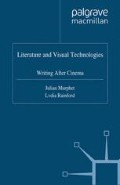Abstract
When we consider the birth of film in 1895, we must recognise that it finds its principal significance for literature as threat and opposition. Whether we consider film from the point of view of the documentary record inaugurated by the Lumière brothers or the peep-show attraction with which Edison started, film very quickly reached audiences on a size and scale that literature could never dream of. As perhaps the most visible evidence of a new commercial mass culture, cinema became for many of the official representatives of literary culture the enemy. If one re-reads I. A. Richards’ influential texts of the 1920s, The Principles of Literary Criticism (1924) and Practical Criticism (1929), one finds that the very justification of literary study is often framed in terms of an antidote to a mass culture of which cinema is the most obvious example. This deep-seated opposition is carried through to the present day. The biggest cheer that the late and unlamented Conservative education minister John Patten ever received at a Conservative Party conference was when he bellowed that he would insist that schoolchildren were taught Shakespeare and not soap-opera. Indeed, this opposition is not simply at work in discourses of cultural criticism or political opportunism. There is a literary sub-genre, the ‘Hollywood novel’, of which the two best examples are Nathanael West’s The Day of the Locust (1939) and Evelyn Waugh’s The Loved One (1948), that finds its fundamental opposition pitting theliterary worker or artist against an uncreative industry which addresses a mass audience.
I would like to thank Julian Murphet whose work on and contribution to this piece are much more considerable than the title of editor would suggest. In particular the final section which he wrote up from the most scanty of final written notes and verbal comments would more properly be attributed to him than to me although it makes the conclusion that I would wish to have written.
Access this chapter
Tax calculation will be finalised at checkout
Purchases are for personal use only
Preview
Unable to display preview. Download preview PDF.
Notes
For more on the Hollywood novel, see Nancy Brooker-Bowers, The Hollywood Novel and Other Novels about Film, 1912–1982: an annotated bibliography (London: Garland, 1985), and Anthony Slide, The Hollywood Novel: a critical guide (London: McFarland & Co, 1995).
For excellent descriptions of this ‘ecology’, see Fredric Jameson, The Cultural Turn, (London: Verso, 1998), pp. 109–113; The Geopolitical Aesthete (London: BFI, 1992), pp. 138–143; and Postmodernism (London: Verso, 1991), pp. 67–69, 275–77.
Walter Benjamin, ‘The Work of Art in the Age of Mechanical Reproduction’, in Illuminations, trans. Harry Zohn (New York: Schocken, 1968), pp. 236–37.
Andre Bazin, ‘In Defence of Mixed Cinema’, in What is Cinema?, Volume One, trans. Hugh Gray (Berkeley: University of California Press, 1967), pp. 60–62.
See the chapter in this volume by Michael North, ‘International Media, International Modernism and the Struggle with Sound’, as well as Part 2, ‘From Silence to Sound’ in Close Up 1927–1933: Cinema and Modernism, edited by James Donald, Anne Friedberg and Laura Marcus (London: Cassell, 1998), pp. 79–95.
James Joyce, Ulysses (London: Penguin, 1992), p. 243.
Rilke, quoted in Salman Rushdie, The Ground Beneath Her Feet (London: Jonathan Cape, 1999), p. v.
James Learmont and Mollie Sayer, A Review of Good Practice in Media Education (London: British Film Institute, 1996).
See David Parker, ‘You’ve read the book, now make the film: moving image, print literacy and narrative. ’ English in Education 33 (1): 24–35.
Tom Gunning, D. W. Griffith and the Origins of American Narrative Film: The Years at Biograph (Urbana: University of Illinois Press, 1991).
Editor information
Editors and Affiliations
Copyright information
© 2003 Colin MacCabe
About this chapter
Cite this chapter
MacCabe, C. (2003). On Impurity: the Dialectics of Cinema and Literature. In: Murphet, J., Rainford, L. (eds) Literature and Visual Technologies. Palgrave Macmillan, London. https://doi.org/10.1057/9780230389991_2
Download citation
DOI: https://doi.org/10.1057/9780230389991_2
Publisher Name: Palgrave Macmillan, London
Print ISBN: 978-1-349-51170-9
Online ISBN: 978-0-230-38999-1
eBook Packages: Palgrave Literature & Performing Arts CollectionLiterature, Cultural and Media Studies (R0)

